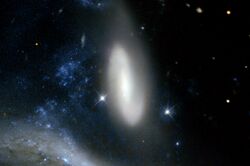Astronomy:IC 4970
| IC 4970 | |
|---|---|
 Lenticular galaxy IC 4970 | |
| Observation data (J2000 epoch) | |
| Constellation | Pavo |
| Right ascension | 20h 16m 57.35s[1] |
| Declination | −70° 44′ 59.1″[1] |
| Redshift | 0.015728±0.000147[1] |
| Helio radial velocity | 4715±44 km/s[1] |
| Galactocentric velocity | 4603±44 km/s[1] |
| Distance | 212×106 ly (65 Mpc)[2] |
| Apparent magnitude (V) | 13.06±0.09[1] |
| Absolute magnitude (V) | −21.00±0.51[1] |
| Characteristics | |
| Type | SA0^- pec:[1] |
| Apparent size (V) | 0.7′× 0.2′[1] |
| Notable features | Interacting galaxy with NGC 6872 |
| Other designations | |
| ESO 73-33, JB a 28-2, LEDA 64415, 2XMM J201657.3-704459 | |
IC 4970 is an unbarred lenticular galaxy of type SA0^- pec: in the constellation Pavo. It is 212 million light-years (65 Mpc) from Earth and is interacting with the barred spiral galaxy NGC 6872.[2] It was discovered on 21 September 1900 by American astronomer DeLisle Stewart.[3]
Interaction with NGC 6872
IC 4970 is located a few arcseconds away from the much larger barred spiral galaxy NGC 6872, and the two are known to be interacting with each other. Horrelou and Koribalski (2007) reported on a computer simulation used to determine how the two galaxies were interacting. The study concluded that IC 4970 approached NGC 6872 nearly along the plane of its spiral disk, making a closest approach approximately 130 million years ago resulting in the latter's current highly elongated shape.[4]
An ultraviolet-to-infrared study by Eufrasio, et al. (2013), using data from GALEX, Spitzer, and other resources found that the interaction between the two galaxies appears to have triggered significant star formation in the northeastern arm of NGC 6872 beginning about 130 thousand light-years (40 kpc) from its nucleus.[5] The same appears to have also occurred in the southwestern arm.[2] A bright ultraviolet source was discovered at the end of the northeastern arm, around 290 thousand light-years (90 kpc) from the nucleus, which may be a tidal dwarf galaxy formed out of the interaction between IC 4970 and NGC 6872.[5] The bright ultraviolet nature of this cluster indicates that it contains stars less than 200 million years old, which roughly coincides with the timeframe of the collision.[2]
References
- ↑ 1.0 1.1 1.2 1.3 1.4 1.5 1.6 1.7 1.8 "Detailed Information for Object IC 4970". NASA/IPAC Extragalactic Database. http://ned.ipac.caltech.edu/cgi-bin/objsearch?search_type=Obj_id&objid=56034.
- ↑ 2.0 2.1 2.2 2.3 "NASA's GALEX Reveals the Largest-Known Spiral Galaxy". NASA. 10 January 2013. http://www.nasa.gov/mission_pages/galex/galex20130110.html.
- ↑ Seligman, Courtney (15 May 2014). "IC 4970 (= PGC 64415)". CSeligman.com. http://cseligman.com/text/atlas/ic49a.htm#ic4970.
- ↑ Horellou, Cathy; Koribalski, Bärbel (March 2007). "Stars and gas in the very large interacting galaxy NGC 6872". Astronomy and Astrophysics 464 (1): 155–165. doi:10.1051/0004-6361:20066023. Bibcode: 2007A&A...464..155H.
- ↑ 5.0 5.1 Eufrasio, Rafael T.; de Mello, Duília F.; Urrutia-Viscarra, Fernanda; Mendes de Oliveira, Claudia; Dwek, Eli (March 2013). "When the Largest Spiral is Formed". Proceedings of the International Astronomical Union 292: 328. doi:10.1017/S1743921313001543. Bibcode: 2013IAUS..292..328E.
External links
- IC 4970 on WikiSky: DSS2, SDSS, GALEX, IRAS, Hydrogen α, X-Ray, Astrophoto, Sky Map, Articles and images
- IC 4970 at SIMBAD
 |


